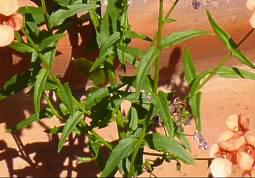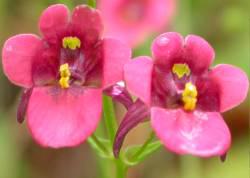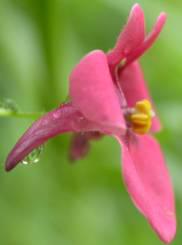Diascia patens
Diascia patens (Thunb.) Grant ex Fourc
Family: Scrophulariaceae
Common names: twinspurs (Eng.); horingkies (Afr.)
Introduction
Little is known about the petite Diascia patens with its clambering habit and long flowering season. It should have made its appearance as a quaint addition to a summer bedding or pot display years ago.

Description
Description
Diascia patens is a low-growing, well-branched, scrambling herbaceous perennial with a woody base. Mature plants vary in height from 0.4-1 m. Light green, hairless leaves are wedge-shaped at the base and taper to a sharp tip. The leaf margins are entire or have a few sharp teeth. The leaf size diminishes upwards towards the inflorescence.

Single flowers are arranged along an elongated, unbranched axis (raceme) forming a lax inflorescence produced on terminal branches which clamber up neighbouring plants for support. Usually Diascia patens has a smattering of small dark pink flowers, however there are forms from the Little Karoo with salmon blooms. Flowers are produced in late spring through summer, and under favourable conditions into autumn. Individual flowers present themselves with a long broad lower lip and four smaller bonnet-type petals with translucent interior markings referred to as windows. The yellow window visible on the upper petals, is fairly deep-set and shallowly concave. The common name twinspurs refers to the two lateral corolla tube spurs, 4-5 mm long, which are straight and diverge at a 45° angle, with a central patch of dark sessile glands present at the base of the lower lip. These glands consist of oil-bearing cells and are called elaiophores. The oil attracts pollinators. Capsules contain urn-shaped seeds which are curved, winged and ridged.

Conservation Status
Status
Least Concern (Raimondo et al. 2009)
Distribution and habitat
Distribution description
Diascia patens is endemic to South Africa and can be found at altitudes of 500-1372 m in the Eastern and Western Cape. Little is known of the species, but from collectors' notations it is accepted that the plants occur in rocky sites and in streamside thickets.
There is a salmon-coloured cultivar, D. patens `Cheeky Chief', which was collected and subsequently selected by a Kirstenbosch horticulturist from a small population which occurs outside of Oudtshoorn.
Derivation of name and historical aspects
History
There are 70 species of Diascia endemic to southern Africa found mostly in the eastern regions including Lesotho, Free State, KwaZulu-Natal and Eastern Cape Province. Most species found in the latter are annuals.
Diascia is derived from the Greek words, di, two, and askos, sac, referring to the pair of translucent yellow sacs/windows in the corolla and not to the two spurs which are absent in the type specimen D. bergiana. Most annual Diascia species follow this example, but in the perennials, the window is single or only slightly doubled. The double spur, though, is a striking characteristic of many Diascia species. The spurs contain glandular hairs which secrete fatty oil. In some species, small dark patches of these tiny glands are also found on the face of the flower. The oil is harvested by members of a genus of bee which evolved to reach into the spurs of the flower.
It is thought that the epithet patens was given by Thunberg because of the characteristically narrow, outspread leaves of the species.
Diascia patens is related to D. capsularis and can be recognised by its 2-4.5 mm broad, narrower, linear leaves, which are not 5-17 mm broad and triangular as in D. capsularis. Other features that set D. patens apart are its shorter spurs, filaments and style.
The first collections of Diascia patens are about two hundred years old. Thunberg made the original collection, but the locality was not recorded. A second journey was made to Kaffraria, the British colony in the southeastern part of the Eastern Cape in the region of King Williams Town and East London. The Langekloof and Uniondale districts were visited during these travels where more collections were made.
Specimens by other early collectors such as Burchell and Taylor have helped solve the puzzle of the locality of Thunberg's original specimen.
Diascia was not described until 1820 and early specimens of D. patens were placed under long-established genera, such as Antirrhinum, Linaria and Nemesia, until they were appropriately classified with regard to their characteristic twin spurs.
Synonyms for Diascia patens are: Antirrhinum patens Thunb., Diascia monasca Hiern, Linaria patens (Thunb.) Spreng., Nemesia patens (Thunb.) G.Don.
Little is still known about this species even though its documentation started so many years ago.
Diascia patens `Cheeky Chief' was collected by a Kirstenbosch horticulturist, A. Harrower, in 2005. Selections based on flower colour, flower size, compactness and a long flowering season were made to bring forth this playful cultivar.
Ecology
Ecology
Diascia species are pollinated by a specialized genus of bee, Rediviva, whose forelegs have evolved to as much as three times their normal length in order to reach into the spurs of the flower, to harvest the fatty oil produced by the glands. This modification seems to be restricted to the females, as few males of the species have been found to have excessively long forelegs. Upon landing on a flower, she will insert her elongated front legs into each hollow spur and probe the ends for the oil-producing elaiophores. The bee's legs are made up of a complex system of setae (bristles) adapted to cutting open oil-bearing cells and absorbing the contents, almost like a sponge. While the female bee is collecting oil with her forelegs extended into the spurs, the flower's anthers are pressed against the body of the bee. Thus pollen is carried from one flower to another and pollination occurs.

Additionally, those species of Diascia which tend to grow together in an area have evolved different arrangements of their stamens so that their pollen is deposited on separate parts of the bee's body, thereby avoiding cross pollination.
Uses
Use
Diascia species and their cultivars are still very popular as summer ornamental herbaceous plants in hanging baskets, pots, rockeries and flowerbeds.
D. patens is a fantastic addition to cottage garden plantings and pots, and complements or softens strong structural plants such as Hebenstretia dura and Pelargonium tongaense.

Growing Diascia patens
Grow
Diascia patens is a hardy, fairly drought-tolerant species. It thrives in sunny or lightly shaded positions. In the wild, it tends to grow along streams or in the moist shade of rocks or large grass tussocks. It can be surprisingly tough for such a delicate-looking plant.
Diascia species are easily propagated vegetatively. Select non-flowering softwood cuttings, 50-60 mm long, taken when the plants are actively growing, in spring. Cuttings usually strike quickly, within two weeks, without heat or special treatment. For hollow-stemmed species it is better to try cuttings with a good node at the end, or heel cuttings taken from basal shoots. Cuttings taken in autumn root and overwinter well, but thrive only once the weather warms up in spring. Plant rooted cuttings into small pots in a humus-rich, friable and well-drained potting mix. Cut back mature plants in midsummer to improve the flower display. Diascia species can regularly receive a good slow-release fertilizer to keep them vigorous and healthy.
Slugs and snails damage small plants. Red spider mite and mealy bug can be troublesome pests which should be treated with an appropriate insecticide, either organic or chemical, as soon as noticed. Lack of sunshine will cause floppy, elongated growth. Usually Diascia species are vigorous and pest free.
References
- Benham, S. 1987. Diascia - a survey of the species in cultivation. Plantsman 9,1: 1-17.
- Elliott, J. 1993. Small and perfectly formed: adaptable, low-growing perennials that won't invade your space. The Garden 118,6: 246-249. Royal Horticultural Society, London.
- Garbutt, S. 1994. Up-and-coming Diascia. The Garden 119,1: 18-21. Royal Horticultural Society, London.
- Goldblatt, P. & Manning, J.C. 2000. Cape plants. A conspectus of the Cape flora of South Africa. Strelitzia 9. National Botanical Institute, Pretoria.
- Hilliard, O.M. & Burtt, B.L. 1984. A revision of Diascia section Racemosae. Journal of South African Botany 50: 269-340.
- Leistner, O.A. (ed.). 2000. Seed plants of southern Africa : families and genera. Strelitzia 10. National Botanical Institute, Pretoria.
- Powrie, F. 1998. Grow South African plants. National Botanical Institute, Kirstenbosch, Cape Town.
- Raimondo, D., Von Staden, L., Foden, W., Victor, J.E., Helme, N.A., Turner, R.C., Kamundi, D.A. & Manyama, P.A. (eds). 2009. Red List of South African plants. Strelitzia 25. South African National Biodiversity Institute, Pretoria.
- Smith, C.A. 1966. Common names of South African plants. Memoirs of the Botanical Survey of South Africa No. 35.
- Vogel, S. 1984. Diascia flower and its bee--an oil-based symbiosis in southern Africa. Acta botanica neerlandica 33: 509-518.
- Whitehead, V.B. & Anthony, N.C. 1984. The bee, Rediviva longimanum Michener (Apoidea: Melittidae), collecting pollen and oil from Diascia longicornis (Thunb.) Druce (Scrophulariaceae). South African Journal of Science 80: 286.
Credits
Monique McQuillan
Kirstenbosch National Botanical Garden
July 2010
Plant Attributes:
Plant Type: Perennial
SA Distribution: Eastern Cape, Western Cape
Soil type: Sandy, Loam
Flowering season: Spring, Early Summer, Late Summer
PH: Acid, Neutral
Flower colour: Pink, Orange
Aspect: Full Sun, Morning Sun (Semi Shade), Afternoon Sun (Semi Shade)
Gardening skill: Average
Special Features:
Horticultural zones










Rate this article
Article well written and informative
Rate this plant
Is this an interesting plant?
Login to add your Comment
Back to topNot registered yet? Click here to register.